By Freeman Rogers
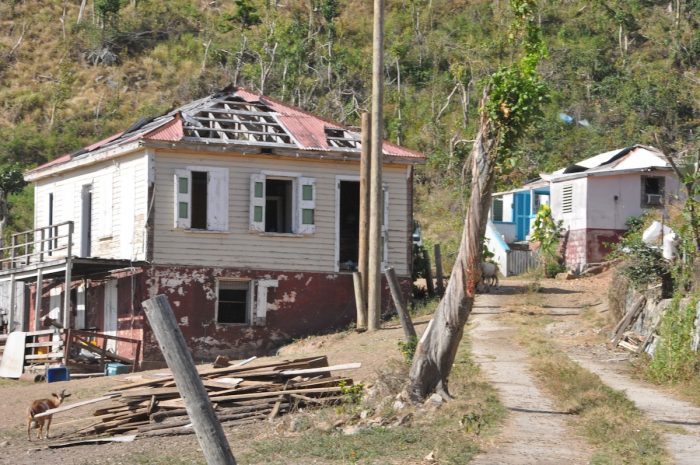

(Photo by Freeman Rogers)
Spanish version here.
When you approach St. John from the water now, the United States Virgin Island at first appears untouched by hurricanes Irma and María. The trees that cover the steep mountainsides —which were stripped bare by the strong winds— are green once again, the seas aqua blue.
But as the ferry pulls in to Cruz Bay, you begin to notice that several buildings lining the harbor are still damaged more than seven months after the storms. Windows and doors are boarded up; a few walls are missing; rafters are open to the air.
About two-thirds of St. John —which has some 4,000 residents, compared to around 50,000 each on its sister islands of St. Thomas and St. Croix— is occupied by the protected Virgin Islands National Park. As a result, the island, which doesn’t even have its own airport, is surrounded by more natural protections than its neighbors, such as reefs, mangroves and forest-covered shorelines that help guard against extreme weather.
St. John nevertheless suffered unprecedented damage in September’s back-to-back hurricanes, and scientists, conservationists and other residents believe that those natural protections are at risk because of the effects of climate change. A coral die-out during a particularly hot 2005 killed some 50 percent of the reef cover that might have helped shield the island — and the storms killed much of what had regrown since then.
Add to that rising sea levels, which are believed to have exacerbated the swells brought by Irma.
“Where I live on Sandy Shore, we lost between 20 and 30 feet of vegetation, so our shorelines since Irma are now even more vulnerable to even slight amounts of sea level rise,” said Eleanor Gibney, a horticulturalist who grew up on the island and who recently gave a talk on the damage that the storms did to the terrestrial environment. “Then we had that nor’easter [storm] in early March, and because there wasn’t a barrier there it killed a lot of vegetation that actually had survived Irma.”
But even as pressures mount, the territory is falling behind many of its Caribbean neighbors when it comes to preparing for climate change.
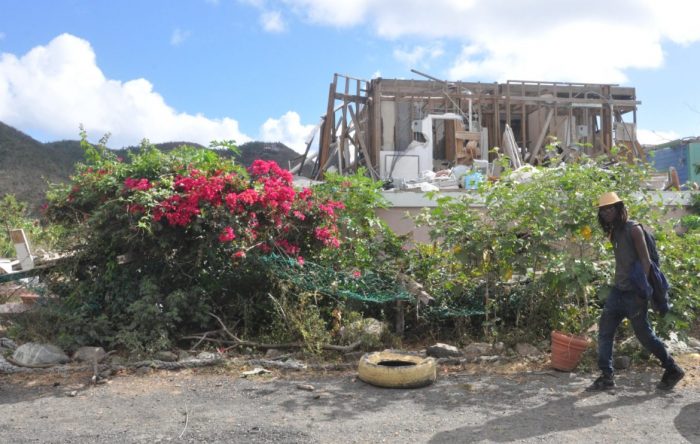

Although St. John is protected by air since it has no airport, and seems to be standing, life has not yet been normalized for some of its residents. (Photo by Freeman Rogers)
Unlike most other islands in the region, the USVI has drafted no climate change adaptation strategy or policy. And although Governor Kenneth Mapp’s administration is promising one soon, the effort could continue to take a backseat under a US president who doubts mainstream scientists’ consensus that climate-change patterns are largely manmade.
“At this point probably the bigger threat to the issue of climate change is that the US government is not going to do anything about it and the huge cadre of scientists that are working for the federal government can’t be working on such an important issue,” said Joe Kessler, the president of the St. John-based non-profit Friends of Virgin Islands National Park. “And that affects a small park like ours.”
This situation — which he finds particularly troubling because so much of St. John is a national park — is a stark contrast from former President Barack Obama’s leadership, he said.
“The Park Service had a fairly robust program concerning climate change under the previous administration,” he said. “And it was one of their key planning points.”
Meanwhile, as a US territory the USVI is ineligible for much of the climate-change funding that wealthy countries and international donors have earmarked for developing states like some of the USVI’s Caribbean neighbors. Some USVI conservationists and scientists also question their own legislators’ willingness to take steps that have been neglected for decades, such as strengthening development rules and establishing environmental protections that could help build resilience.
Dangers of Inaction
Leaders’ ability to take action quickly could be a matter of life or death.
If the situation is dire in the relatively undeveloped St. John, then St. Thomas and St. Croix, where natural protections have been more dramatically depleted by development and other pressures, face greater risk.
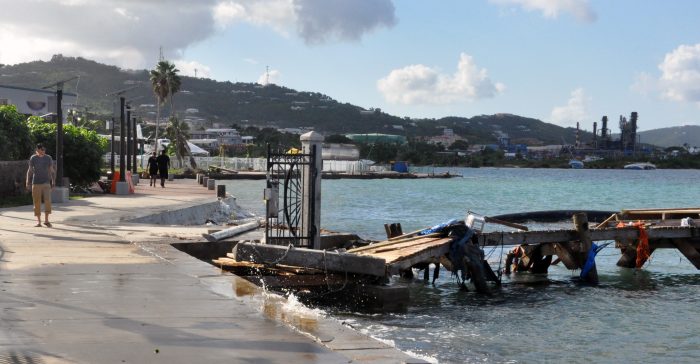

St. Croix (Photo by Freeman Rogers)
Last year’s hurricanes dramatically exposed weaknesses in the entire territory’s infrastructure and essential services. Irma ripped off part of the roof of the aging Roy Lester Schneider Regional Medical Center on St. Thomas as terrified patients huddled inside. About two weeks later, María wrought similar destruction on St. Croix’s Juan F. Luis Hospital.
As a result, more than 400 patients were evacuated to the mainland United States. Local news reports suggest that some 50 of them died there, though this number hasn’t been confirmed, and according to the Federal Emergency Management Agency (FEMA) nearly 200 still haven’t returned, in part because the medical facilities back home remain inadequate for their needs.
Most of the territory also lost electricity, which wasn’t fully restored until March, and communications went down in many areas for months.
“The electricity has been difficult, but if you have a generator and batteries and things like that you can sort of figure out how to live, but the lack of communication has been catastrophic,” said Sharon Coldren, the president of the Coral Bay Community Council on St. John. “The disaster agencies, FEMA, the police, all depend on you having some sort of wireless communication. They want you to call an 800 number, they want you to go online, and we couldn’t do it.”
The tourism industry suffered a serious blow as well. In St. John, for example, Mr. Kessler and other residents said the storms exacerbated simmering community tensions after the corporate owners of the iconic Caneel Bay Resort decided that before rebuilding they want to renegotiate the agreement that allows them to operate on national park land. If not resolved in a timely manner, the resulting dispute could delay the reconstruction by years, thereby prolonging the pain for the small island’s delicate economy: Before the storm, the resort —which was founded by U.S. businessman and philanthropist Laurance Rockefeller in 1956— employed about one in 10 of the island’s residents.
Many roads also suffered extensive damage, making it difficult for some residents even to get to the store for basic supplies in the days after the storm.
“What Irma showed me is that we’re not prepared for massive rains,” said Dr. David Smith, a St. Thomas physics professor who has taught for 32 years at the University of the Virgin Islands, adding, “We’ve had plenty of roads that I thought were just as solid as they could be, and they’re gone.”
Because of such issues, much of the recent talk about recovery has centered around hardening the infrastructure.
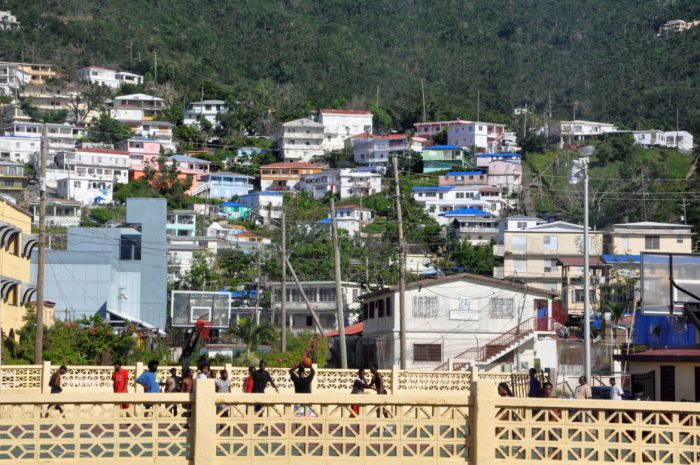

Urban areas in St. Thomas, the most developed USVI, offer contrast to nature conservancy sister island of St. John. (Photo by Freeman Rogers)
“There has to be a bias in favor of a hardened system, because we know that we live on borrowed time down here,” said St. Thomas attorney Leigh Goldman.
The When, What and Why of Recovery Funds
To help the territory rebuild stronger, Congress approved a disaster-recovery bill that USVI leaders said would bring in some $7.5 billion.
Schools are to be more resilient, and Mr. Mapp has said that his government will work toward constructing smaller, more hardened medical facilities. Meanwhile, the Water and Power Authority has partnered with FEMA to strengthen the power grid, replacing many wooden power poles with stronger composite ones in several locations and burying power lines in others.
But climate change has been largely absent from the territory’s public dialogue. When Governor Mapp delivered his State of the Territory Address in January, for example, he didn’t mention the phrase once.
“It seems like we’re mostly reacting to things,” said Jennifer Valiulis, the acting director of the St. Croix Environmental Association, adding, “There’s some talk of making the infrastructure stronger, but not necessarily a whole lot of mention of climate change and the fact that this might be a more regular thing that happens. Hopefully, once we get back on our feet a little bit more [it won’t be] just this day-to-day ‘Who’s got power and who doesn’t? Who’s got phones and who doesn’t?’”
The governor’s seeming reluctance to dwell on climate change puts him in stark contrast to many of his neighbors in the region. Dominica Prime Minister Roosevelt Skerrit, for one, has used the phenomenon as something of a rallying cry, taking to the world stage to request funding and to promise —albeit with more sound than specifics— to make his country the first “climate-resilient nation” in the world.
On St. John, Mr. Kessler, of Friends of VI National Park, said he has noticed that federal employees in the territory are now reluctant to talk about climate change—a trend that he attributed to President Donald Trump’s administration in Washington.
“The U.S. government has their head in the sand about it and officially the Park Service really can’t do anything about climate change because according to the Secretary of the Interior it doesn’t exist,” he said. “And so it kind of puts people in a kind of a quandary: How do you prepare for it when the agency essentially doesn’t accept it?”
No Strategy
At a time when countries and territories around the Caribbean have been drafting —though not necessarily following— adaptation strategies, the USVI has not done so in spite of an executive order Mr. Mapp issued in 2015, when Mr. Obama was still in office.
His directive mandated the formation of a climate change council to create three documents: a public engagement strategy by April 2016; an adaptation policy by October 2016; and an adaptation strategy by October 2017.
The council, however, never formally met, according to Shawn-Michael Malone, the federal affairs coordinator in the Office of the Governor.
Mr. Mapp did not grant an interview for this investigation, but Mr. Malone blamed politics and funding for the council’s failure to accomplish its mandate.
“We applied for $2 million [under the Obama administration], but we only got … close to a million,” Mr. Malone said. “They expected us to be creative and to use existing resources that we had to augment the $825,000 to do [a vulnerability] assessment, and that’s not much money.”
Further expected funding was not forthcoming after Mr. Trump took office, according to the coordinator.
“During the campaign, Trump said he doesn’t believe in climate change, and the Republicans have in so many ways said this is a hoax,” he said, adding, “So we have to be creative and find our own resources.”
Nevertheless, Mr. Malone explained, the vulnerability assessment is continuing and should be completed in December. And after the hurricanes last September, the work that would have been done by the climate change council has been taken over by a recovery task force, he said, adding that he hopes a strategy will be complete in time to take effect by spring of next year.
Still, success will depend on funding. As a U.S, territory, however, the USVI is ineligible for much of the outside funding that has been driving preparations in other countries.
The Caribbean Community Climate Change Centre, Mr. Malone explained, “has lots of funding for other islands, but because we’re United States we can’t access the funding, … so we’re handicapped here. We have to rely on private American funding like the Bloomberg Foundation and our own resources, because our economy was challenged even prior to the hurricanes.”
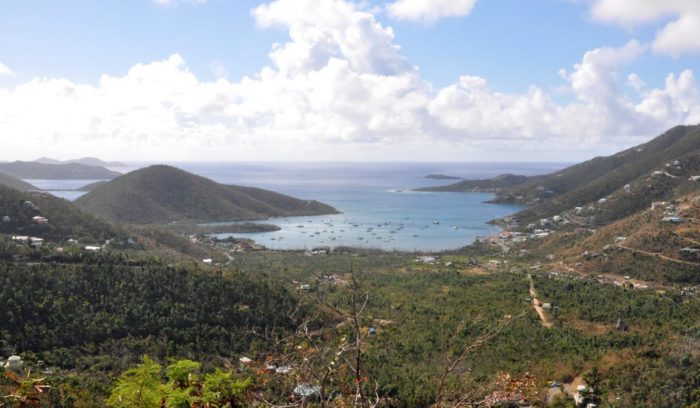

Most economic activity in the USVI is directly linked to the tourism sector, and more specifically to the ocean, accounting for 60% to 80% of the islands’ GDP. St John here. (Photo by Freeman Rogers)
Before the storms, the territory already was struggling to meet its debt obligations — which included some $6.5 billion owed to pensioners and creditors — to the point where some analysts had raised concerns about a fiscal collapse like the one that has bankrupted Puerto Rico.
Other Mitigation Measures
Besides hardening infrastructure, scientists and conservationists in the USVI advocate for preventive measures to protect coral, mangroves, wetlands and other natural features that can offer protection against the effects of climate change.
Many of their suggestions have been recommended for decades —and sometimes promised by legislators and other policymakers— without substantive action.
“The big thing that we really need, and that has been attempted, but not successfully, is a comprehensive land and water use plan,” said Ms. Valiulis, of the St. Croix Environmental Association. “We haven’t looked at the territory as whole and said what percentage of our wetlands do we want to have protected; what percentage of our forest do we want to have protected? And so each development is looked at piecemeal, and that can become a problem when one after another you carve out the forest or you carve out the wetlands.”
Such a plan was completed in 1995 but never adopted by the legislature. And although a federal Coastal Zone Management program regulates shoreline development in many areas, inland projects are not subject to the same scrutiny.
Given the steep topography of much of the territory, this arrangement leaves coral and other marine ecosystems vulnerable, according to Dr. Tyler Smith, an associate professor of marine biology at the University of the Virgin Islands.
“You need a different level of permitting to build in [the coastal zone], which is usually within 100 feet of the waterfront,” Dr. Smith said. “But really whatever happens up on the top of the highest point on these mountains ends up the same day in the water.”
In the past, conservationists have advocated to extend the coastal protections inland, but they did not succeed.
Dr. Smith added that guidelines designed to reduce runoff also need to be better enforced.
“You are supposed to when you construct have silt fencing in place,” he said, “but they’re not very effective, especially on the slopes, and even if they are installed they’re often just neglected. There’s very little inspection, enforcement.”
The result, he said, is damage to reefs that help protect the shores from storm surge. During the Indonesian tsunami in 2004, he explained, scientists found that areas behind healthy coral reefs survived better.
“The reef slowed down the wave and buffered it to some degree,” he said.
Restrictions Are Unpopular
However badly development restrictions may be needed, they often are unpopular for economic reasons in this tourism-dependent territory, where unemployment was already about 10 percent —more than twice the national average— before the storms, explained consultant Roy Watlington, a retired physics professor who taught oceanography and other subjects during his 27-year career at the University of the Virgin Islands. Tourism accounts for between 60% and 80% of USVI’s Gross Domestic Product, according to a National Oceanic and Atmospheric Administration 2016 study.
Developers, Mr. Watlington said, not surprisingly tend to promote the economic benefits of their project.
“They act as if their primary goal is to bring this great project that will bring jobs to the Virgin Islands,” said Mr. Watlington, who served on a task force that gave recommendations on the 2015 executive order to establish a climate change strategy. “And what politician would survive being thought of as anti-job?”
At times, he added, penalties aren’t high enough to deter developers from breaking the rules.
“We’ve had developers who were very cavalier in their behavior and who didn’t act like they cared about the restrictions,” he said. “They felt more comfortable paying the relatively small fines than to slow down the process of building.”
Such issues are exacerbated in a territory where many tourists want to be as close to the ocean as possible.
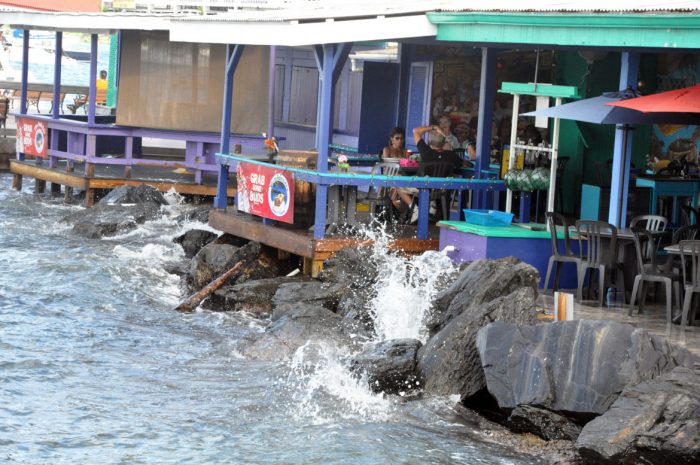

Much of the economy of the USVI is dependent on ocean tourism and many businesses, located on the coasts, are suffering from erosion and rise in sea level. (Photo by Freeman Rogers)
On the southern shore of St. Croix, the 180-room beachfront Divi Carina Bay Resort and Casino was battered by wind and waves during Maria. By December, the all-inclusive resort still stood empty, with parts of its roof missing. The concrete by its oceanside pool had buckled, and multiple rooms were open to the air.
The resort, which hopes to reopen before the end of 2018, wasn’t the only one to suffer a similar fate. Beachfront accommodations across the territory were largely destroyed, and as of March 1 —the most recent date the VI Tourism Department has provided statistics— only about 40 percent of accommodations were open and accepting guests.
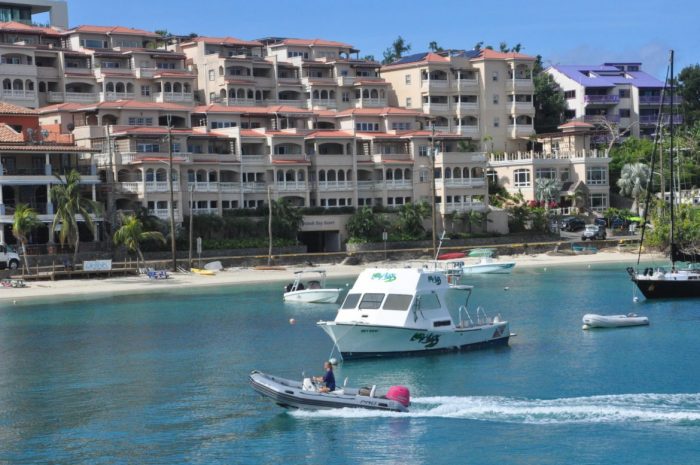

Cruz Bay in St. John is key to ocean related economy. (Photo by Freeman Rogers)
When rebuilding oceanfront resorts, Mr. Watlington called for compromise.
“The Indian Ocean and Japanese tsunamis showed us that some buildings do survive,” he said, adding that “breakaway” lower walls can increase resilience. “That way they can blow out and the water can go through. So you sacrifice the first floor.”
In the future, he added, beachfront developments should be required to include such measures.
“All coastal construction should assume inundation,” he said.
But even such straightforward regulations often aren’t easy for legislators to push through.
“I think the hurricanes that we have suffered would make us inclined to be among the more progressive communities, but the lack of science education in the populace might make it difficult for politicians to justify spending a lot of money for climate change,” Mr. Watlington explained.
In the past, he added, much of the push for reform has come from outsiders.
“Many Virgin Islanders do not know how beautiful some locations are,” he said. “So a lot of the times, you find the people who are defending the environment are expats.”
However well-intentioned and skilled they may be, their efforts can backfire.
“If it seems like an outsider group is coming in and keeping the little man from getting a job, that doesn’t work out,” Mr. Watlington explained.
Any solution?
“Education,” he said.
Responsibility
Other residents stressed the importance of personal responsibility in preparing for storms and other effects of climate change.
John Macy, a retired charter captain on St. Croix who is known as “Big Beard,” said he was surprised by how few people seemed to remember the destruction wrought by Hurricane Hugo in 1989.
“When an island’s wiped out without power and hundreds or thousands of people are scrambling for a generator — didn’t you learn that lesson before?” he said, adding that he bought a house generator after Hurricane Marilyn in 1995. “Why don’t you have a generator and a stash of gas and be ready?”
With Hugo in mind, he added, he took extensive steps to protect his own home before Irma and Maria, going so far as to tie down his roof with straps. And as for the two boats owned by Big Beard’s Adventure Tours, each was secured with 14 anchors in the Salt River area, which is sheltered by mangroves and other natural features.
The preparations worked: His home and boats survived with only minimal damage.
St. Croix artist Jose “Borah” Joseph said he hopes the storms will change attitudes on his island.
“I think the hurricane did a good job,” Mr. Joseph said as he cooked dinner on a December evening on a fire in front of his Grove Place home, which hadn’t had electricity since Maria.
“Because how things was going on in the place, it was like for us to open our eyes and show us what we need to straighten up and get ready for and fix, you know what I mean?”
Back on St. John, a small stone building had stood near the ocean at Cinnamon Bay for more than 300 years.
During Irma, waves crashing over the eroded beach demolished the historic structure, which had been serving as a museum of archaeological artefacts found in the national park that occupies about two-thirds of St. John.
“I can look at it from my deck,” said Rafe Boulon, a former Virgin Islands National Park scientist who grew up on the island. “I noticed that within five minutes after crawling out of my house after Irma. It’s quite a loss actually for our island, and for history and our cultural resources.”
This story is part of the series ISLANDS ADRIFT, the result of the work of a dozen Caribbean journalists led by the Center for Investigative Journalism (CPI) in Puerto Rico. The investigations were possible in part with the support of Ford Foundation, Para la Naturaleza, Miranda Foundation, Ángel Ramos Foundation and Open Society Foundations.


